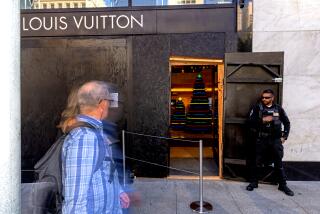Bank Heists Become a Gang Crime : FBI, police see new dimension of violence and terror in robberies
- Share via
In 1993, FBI spokesman John Hoos, among others, first commented on some emerging trends involving Southern California bank robberies.
In that year, far fewer of the bank robbery suspects captured by the FBI were so-called professional bandits and drug addicts. Instead, they appeared to be gang members.
This new trend came at a time when many Los Angeles street gangs had tired of the relatively meager pickings offered by convenience store holdups. These gang members also were believed to be much better armed, in part with some of the thousands of weapons pillaged from gun shops during the 1992 Los Angeles riots. The street gangs began to move up to tackle bank robberies.
And now, even in the midst of a tremendous decline in both bank robberies and so-called takeover bank holdups in Los Angeles, the involvement of street gangs continues to grow. This development adds a new dimension of violence and terror to bank heists.
Now, Hoos says, 80% of those who commit bank robberies in this city are gang members. The comment was made in connection with a story about a May 2 bank heist in Van Nuys in which robbers briefly took 30 adults and children hostage. The three suspects fired a burst of shots, threatening to shoot anyone who stood up.
“We’re talking about some very dangerous people here with no qualms about using high-powered weapons,” Los Angeles Police Sgt. Joseph Brazas said of the incident.
Bank officials, the FBI and police attribute the growing violence during bank heists to street gangs.
This may be something to keep in mind the next time some community activist or city official becomes joyously breathless over the next gang truce, in which the street urchins have merely agreed to avoid shooting each other. The bank robberies serve as stark proof of another way in which criminal street gangs menace society.
More to Read
Sign up for Essential California
The most important California stories and recommendations in your inbox every morning.
You may occasionally receive promotional content from the Los Angeles Times.










